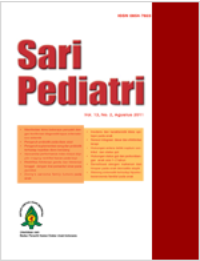Dampak Jangka Panjang Terapi Hormonal Dibandingkan Pembedahan pada Undesensus Testis
Sari
Latar belakang. Pemberian terapi hormonal pada undesensus testis (UDT) masih direkomendasikan di Indonesia sedangkan
Consensus Report of Nordic Countries menyatakan bahwa terapi lini pertama untuk undesensus testis adalah operasi dan terapi
hormonal tidak direkomendasikan lagi.
Tujuan. Mengevaluasi dampak samping terapi hormonal dan pembedahan pada undesensus testis berdasarkan bukti ilmiah.
Metode. Penelusuran pustaka database elektronik : Pubmed, Cochrane, Medline, Pediatrics.
Hasil. Terdapat 11 penelitian mengenai dampak terapi pada UDT. Lima penelitian prospektif melakukan pemantauan sampai
usia pasien 3 tahun sedangkan 6 penelitian lainnya merupakan studi potong lintang pada pria dewasa dengan riwayat undesensus
testis. Volume testis dan kualitas sperma lebih rendah pada pasien yang memiliki riwayat terapi hormonal dibandingkan dengan
pasien yang menjalani pembedahan saja. Risiko infertilitas meningkat (OR 4,7) pada pasien yang menjalani terapi hormonal.
Risiko keganasan meningkat jika pembedahan dilakukan lebih dari usia 10 tahun.
Kesimpulan. Terapi hormonal pada UDT dapat meningkatkan risiko infertilitas di kemudian hari oleh karena itu terapi hormonal
sebaiknya tidak dianjurkan. Pasien dengan UDT berisiko menderita keganasan testis di usia dewasa dan orkiopleksi dini (sebelum
usia 12 bulan) terbukti menurunkan risiko tersebut.
Kata Kunci
Teks Lengkap:
PDFReferensi
Penson D, Krishnaswarni S, Jules A, McPheeters
ML. Effectiveness of hormonal and surgical therapies
for cryptorchidism: a systematic review. Pediatrics
;131:1897-907.
Batubara JRL, Setyanto DB, Firmansyah A. Natural
history of cryptorchidism of live births up to 9 months
of age in Cipto Mangunkusumo Hospital. J ASEAN
Federation Endocrine Soc 1999;17:20-8.
Barthold JS, González R. The epidemiology of congenital
cryptorchidism, testicularascent and orchiopexy. J Urol
;170:2396–401.
Miller DC, Saigal CS, Litwin MS. The demographic
burden of urologic diseases inAmerica. Urol Clin North
Am 2009;36:11–27.
Campbell MF, Wein AJ, Kavoussi LR. Dalam: Campbell-
Walsh, penyunting. Urology. Edisi ke-9. Philadephia:
Saunders;2007.h.1223-65
Bertelloni S, Banroncelli GI, Ghirri P, Spinelli C, Saggese
G. Hormonal treatment for unilateral inguinal testis:
comparison of four different treatment. Horm Res 2001;55:236-9.
Henna MR, Del Nero RG, Sampaio CZ, Atallah AN,
Schettini ST, Castro AA, dkk. Hormonal cryptorchidism
therapy. Pediatr Surg Int 2004;20:357-9.
Suryawan WB, Batubara JRL, Tridjaja B, Pulungan
AB. Gambaran klinis kriptokidismus di poliklinik
endokrinologi anak RS Cipto Mangunkusumo Jakarta
-2002. Sari Pediatri 2003;5:111-6.
Buku ajar endokrinologi anak. Testis dan gangguannya.
Dalam: Batubara JRL, Tridjaja B, Pulungan AB,
penyunting. Jakarta: Badan penerbit IDAI;2010. h.73-
Abaci A, Catli G, Anik A, Bober E. Epidemiology,
classification and management of undescended testes:
does medication have value in its treatment. J Clin Res
Pediatr Endocrinol 2013;5:65-72.
Ritzen EM. Undescended testes: a consensus of
management. Eur J Endocrinol 2008;159:87-90.
Dunkel L, Taskinen S, Hovatta O, Tilly JL,Wikstrom
S. Germ cell apoptosis after treatment with human
chorionic gonadotropin. Horm Res 1988;30:198-205.
Feyles F, Peiretti V, Mussa A, Manenti M, Canavese F,
Cortese MG, Lala R. Improved sperm count and motility
in young men surgically treated for cryptochidism in the
first year of life. Eur J Peditr Surg 2013;34:176-83.
Hjertkvist M, Lackgren G, Ploen L, Bergh A. Does HCG
treatment induce inflammastion-like changes in undescended
testes in boys? J Pediatr Surg 1993;28:254-8.
Cortes D, Thorup JM, Visfeldt J. Cryptorchidism: aspects
of fertility and neoplasms. Horm Res 2001;55:21-7.
Lee PA. Fertility after cryptorchidism: epidemiology and
other outcome studies. Urology 2005;66:427-31.
Cortes D, Thorup J, Visfeldt J. Hormonal treatment
may harm the germ cells in 1-3 year old boys with
cryptorchidism. J Urol 2000;163:1290-2.
Kaleva M, Arsalo A, Louhimo I, Rapola J, Perheentupa
J, Henriksen K, Toppari J. Treatment with human
chorionic gonadotrophin for cryptorchidism: clinical
and histological effects. Int J Androl 1996;19:293-8.
Demirbilek S, Atayur HF, Celik N, Aydin G. Does
treatment with human chorionic gonadotropin induce
reversible changes in undescended testes in boys? Pediatr
Surg Int 1997;12:591-4.
Wood HM, Elder JS. Cryptorchidism and testicular
cancer: separating fact from fiction. J Urol 2009;181:452-
Zivkovic D, Bica DG, Hadziselimovic F. Effects of
hormonal treatment on the contralateral descended testis
in unilateral. J Pediatr Urol 2006;5:468-72.
Thorson AV, Christiansen P, Ritzen M. Efficacy and
safety of hormonal treatment of cryptorchidism: current
state of the art. Acta Paediatr 2007;96:628-30.
Giannopoulos MF, Ioannis G, Vlachakis IG, Charissis
GC. Thirdteen years experience with combined
hormonal therapy of cryptorchidism. Horm Res
;55:33–7.
DOI: http://dx.doi.org/10.14238/sp17.3.2015.229-33
Refbacks
- Saat ini tidak ada refbacks.
##submission.copyrightStatement##
##submission.license.cc.by-nc-sa4.footer##
Email: editorial [at] saripediatri.org


Sari Pediatri diterbitkan oleh Badan Penerbit Ikatan Dokter Anak Indonesia
Ciptaan disebarluaskan di bawah Lisensi Creative Commons Atribusi-NonKomersial-BerbagiSerupa 4.0 Internasional.




